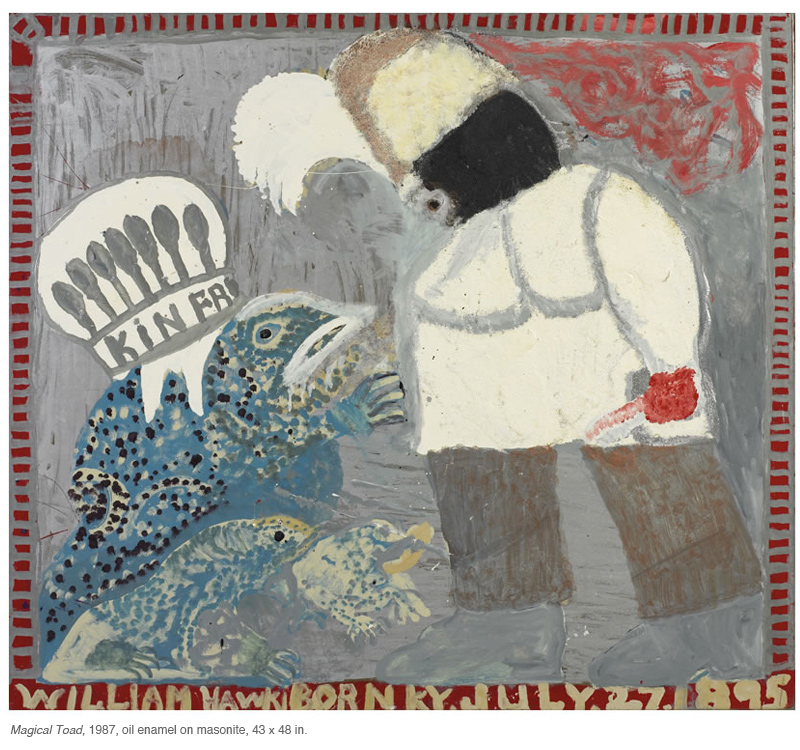
WILLIAM HAWKINS: “watch the painting make itself.”
Trail Reide, 1982.
About:
To accompany William Hawkins on his walks through the streets of his Columbus, Ohio, neighborhood was like following an experienced prospector in search of gold. Hawkins’s selective eye seized images from newspapers, magazines, and advertisements for a suitcase archive he kept in his bedroom. He combined these images with his own recollections and impressions to create a vivid picture gallery of animals, American icons such as the Statue of Liberty, and historic events. And although Hawkins could barely read and write, he transformed words themselves, usually represented by his signature and birth date and often his place of birth, into powerful visual elements.
 Three Hanging Men, 1985.
Three Hanging Men, 1985.
Born in rural Kentucky in 1895, Hawkins came north in 1916. His early years in Kentucky provided him with his knowledge and love of animals, an awareness that informs even his most fantastic dinosaur paintings. In Columbus, Hawkins held an assortment of unskilled jobs, drove a truck, and even ran a small brothel. He was married twice and claimed to have fathered some twenty children. Although Hawkins was drawing and selling his work as early as the 1930s, he did not begin painting in the style for which he is best known until the mid-to late 1970s. He worked almost without letup thereafter, in spite of illness and advancing age.
 At first, Hawkins used inexpensive and readily available materials: semi-gloss and enamel paints in primary colors tossed out by a local hardware store, and a single blunt brush. Later, when he could afford it, he painted on Masonite, which he preferred because it didn’t “suck up the paint” like cardboard or plywood. Sometimes he dripped paint or let it flow across the surface as he tilted it so he could, as he put it, “watch the painting make itself.” He often painted elaborate borders around his pictures and attached such materials as wood, gravel, newspaper photos, or found objects.
At first, Hawkins used inexpensive and readily available materials: semi-gloss and enamel paints in primary colors tossed out by a local hardware store, and a single blunt brush. Later, when he could afford it, he painted on Masonite, which he preferred because it didn’t “suck up the paint” like cardboard or plywood. Sometimes he dripped paint or let it flow across the surface as he tilted it so he could, as he put it, “watch the painting make itself.” He often painted elaborate borders around his pictures and attached such materials as wood, gravel, newspaper photos, or found objects.
 Hawkins suffered a stroke in 1989, from which he only partly recovered, and he died several months later, in 1990. He once summed up his aspirations as an artist by remarking, “You have to do something wonderful, so people know who you are.”
Hawkins suffered a stroke in 1989, from which he only partly recovered, and he died several months later, in 1990. He once summed up his aspirations as an artist by remarking, “You have to do something wonderful, so people know who you are.”
William Hawkins Estate
and
Ricco Maresca Gallery
529 West 20th Street, 3rd Floor,
New York, New York 10011
We are located in the 529 Arts Building in between 10th and 11th ave.
CORRESPONDENCE
Gallery Email: info@riccomaresca.com
